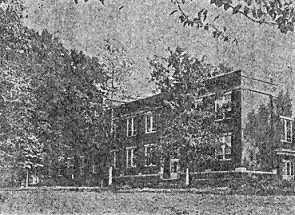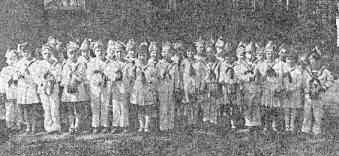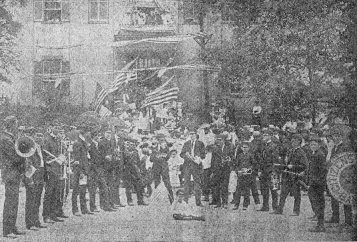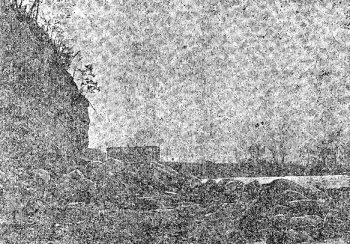
Present Rockport Schools Originated From A Dirt Floored Log Cabin
From February 11, 1955 Centennial Edition The Rockport Democrat
(By Roy D. Bauman)
There is no available record of the first school in Rockport, but about 1822 a man by the name of George Moffitt taught in a round log cabin, which stood just north of the present cemetery. The building, as Squire Bennett quaintly remarked, "had the best kind of a dirt floor," had a fireplace the entire end of the room, had a window made by leaving out a log on one side, and had a roof fastened down by weight poles, and a door which revo lved on wooden hinges. To this rude typical Hoosier schoolhouse came the Bennetts, Bradleys, Browns, Wakefields, Grasses, Snyders and others of the town families who wanted so much to learn to read, write and cipher. As early as 1825 a man named Price taught in a log building that had been built by John B. Greathouse, and used for a time as a tannery. He had quite a full school. Dr. Stevens taught after him in a vacated log house that had been used by a family named Hughes. After this, James Robb, Dr. Moore, William G. Thomas and probably Mr. Moffett taught in any building suitable which they could find. These schools were all supported by subscription, usually from $1 to $2 per quarter and only the rudimentary branches were taught, even though these teachers were of more than ordinary intelligence and had better than average educations. In 1833 a man named Duncan was teaching in the upper story of the Court House. A fire for warmth was necessary and in some manner the woodwork became ignited during the night and the next morning the building was a mass of ruins. All contents of the building were lost, and the school had to find other lodgings. It was soon after this that the county seminary was built.
An early law of the State provided that fines before Justices of the Peace and the Circuit Court would be used to found a fund for the construction and maintenance of a County Seminary. The law further provided that when the fund amounted to $400.00, the County Board at their option could erect a building and commence school. The county was no sooner organized than the fund began to accumulate, much of the money being derived from fines before Justices of the Peace. The number of fines from $1 to $5 for assault and battery during the early history of the county is phenomenal, and should give the period the designation of "Fist and Skull Age". At any rate the fund grew rapidly and in not too long a time the Trustees were ready to build the new school.
On May 4, 1834, the Trustees chose lot 37 with 2 acres of land adjoining, in the Hynes Donation to the city of Rockport as the site for the new seminary, and a new brick building was erected. This location is now the northeast corner of Fourth and Seminary streets and the old building is a part of the house now occupied by Floyd Thurman and his family. Although designed by law as an educational building for the entire county, it was not thus used, though no fault of Rockport was evident. It was doubtless the lack of transportation that kept students from outside the immediate vicinity from attending this modern institution. Mr. Allen Kinchloe, a good disciplinarian and a competent instructor taught the first classes in the Seminary. From 1830 until his death in 1874 this man was a guiding influence in the life of the town. "Mr. Kinchloe was a slender man with dark eyes and hair, but intellectually and morally he was a giant. He was a master of pure and simple English and spoke eloquently, but in a manner that all could understand." This was a description of this teacher as given in an old history of Spencer County. For many years the Seminary was the cultural and social center of the community. Here literary programs were held every Friday afternoon, musicals were given from time to time, and other societies met. During this time select schools were held in the basement of the old Methodist Church, in the Court House, and in available rooms throughout the town. Changes in teachers were many, several of whom were: James C. Veatch, J. H. Smith, John Proctor, (a Harvard graduate), Thomas D. Boyer, Fannie Markle, Mrs. Sherrod, Mrs. Mosby, and Miss Tula Kinchloe. Mrs. John Atkinson, a well educated woman of French descent, taught in her home. All her sons became successful teachers and her grandson, Mr. Ben H. Atkinson, is now a teacher in the Rockport High School.
In 1853 a law was passed to permit sale of the seminary, and by 1855 this had been accomplished, the funds being transferred to a common School Fund. It was the desire of the leaders of the day to build a larger building, to house more students and actually be what we now call a High School building. However, it was not until 1867 that the brick building now called the Seminary was built at a cost of $4000.00. This became the High School building, and since early records are missing, much of the early history of the school in this house is lost. Among the teachers were Prof. Sarver, Allen Kincheloe, William Barnett, William H. Thomas, L. B. Deason, and Miss V. Kinchloe. Here it was that the High School was founded, and here the Teachers’ Institute was held. After the purchase of the college building in 1873, the seminary was, and is yet, used for the lower grades.
The Rockport Academy, or Collegiate Institute, was organized in the year 1857 by prominent men of the Methodist Episcopal Church, at the head of which were Revs. Dr. E. H. Sabin, Dr. H. S. Talbott et al. It was decided to construct a building costing, in round numbers, $20,000, and this amount was divided into shares of $20. A major part of the subscription was sold by 1858 and the building was started in that year. The Trustees at the time were J. W. B. Moore, N. Pyeatt and William Jones; H. S. Talbott, Agent, J. J. Hight, J. M. Green and F. A. Heuring, visitors. Building went so slowly that it wasn’t until July 11, 1859 that the cornerstone was laid. This was a very impressive ceremony, and a large crowd congregated to witness the proceedings. Thomas F. De Bruler called the assemblage to order and explained the importance of the occasion. James C. Veatch placed in the stone a tin box containing a copy of the subscription and association of the academy, a Bible, various United States coins, bills of the Mining and Manufacturing Bank of Rockport, and copies of several newspapers. To conclude the meeting Dr. Sabin delivered an interesting discourse on the subject of "Female Education". The Rockport Brass Band furnished music for the occasion. The building was 50x70 feet, three stories high, and hope was held that it would be ready for use in a very short time. However in 1861 the war came on and the building was still not completed. In 1863 the name of the school was changed from "Rockport Academy" to "Rockport Collegiate Institution" and in September of that year the institute was formally opened. There were fifty students under Prof. W. S. Hooper, Principal, and several assistants, one of whom was Miss Sue Hooper, sister of the principal, a woman of very high literary and moral character, who "became the life of the school with her energy and spirit." By 1864 there were 135 students enrolled for the year, a new piano was purchased for $425, a set of Philosophical apparatus for $500, and the Institute and grounds was valued at $31,000. The presence of the Institute began to be felt, young people took more interest in education, parents were gratified, and the whole thing was the pride of Rockport. One hundred and ninety seven students were enrolled by 1866, of which many were from other localities; such was the fame of the Institution. Young ladies were graduated with a full college course, and young men were prepared for the higher classes in universities. As General James C. Veatch said at the time: "Our society here bids fair ere long to become a most powerful means of disseminating truth and eradicating error. Nor would the figure be overstrained were we to imagine that we already see the pale, crippled and haggard ranks of ignorance and error recoiling before the well directed aims of the invincible phalanx of free discussion and patient investigation." The school did very well for a few years, but by 1873 the enrollment was falling off due to the establishment of free public schools, and the Collegiate Institute became involved in debt. The Indiana Conference of the Methodist Church failed to come to the rescue and in a short time the building and grounds were sold to the town of Rockport for $9800. Since that time the building has been used for the Rockport High School.
In 1873 the school trustees were R. T. Kercheval, Oliver Failing and John Wyttenbach. Walter Welch was superintendent. In 1875-76 the superintendent was O. H. Smith, and in 1878 A. H. Kennedy became superintendent. Mr. Kennedy guided the school into the position of being one of the most meritorious in the state, and it afforded good education to the children of the day. The course embraced three years of three terms each. From that time on, the school increased in standing in the community.
After the Rockport Public Schools were established, and for a good many years thereafter, there was a constant shifting of classes from one building to another, and from one location to another, so it is hard at this time to completely outline the location of the various units of the schools. We do know that following the purchase of the College in 1874, High School classes were transferred to the new location, and put on the second floor. Grades 5, 6, and 7 occupied the first floor. What might have been known as the 8th grade was included in a four year high school course. The third floor of the building as we know it was unused. Primary grades were located at the Seminary except it was deemed too far to walk for the first grade children on the north side of town, side walks being what they were in those days. A frame house was purchased on North 5th Street just North of the German Lutheran church (mentioned below as the present site of the Colored Sumner School), and Division A of the first grade attended there. Children of the South side of Rockport attended Seminary. This arrangement continued until the middle 1880’s when Division A was moved to the Seminary building, combined with the second grade, with half day sessions for each. The fifth grade was moved back to the Seminary, an eighth grade was organized under a separate teacher, and the high school reduced to a three year course. It still occupied the second floor, and was not moved to the first floor until 1892, when the 8th was moved to the second floor, and the 6th and 7th grades were moved to the third floor. In 1892 the first and second grades were divided and a teacher employed for each. The 5th grade was returned to the high school building while a two story addition on the south side of the Seminary was being completed, after which it was returned to Seminary. The south room on the first floor was used for a kindergarten for several years after that. In 1894 a fourth year was added to the high school course.
To relieve the crowded conditions in the schools at the time, the Washington Building was begun in 1900. This was to house some of the first three grades, but in 1910 the school board decided to use the Seminary for Manual Training and Home Economics departments, and for grades 5, 6, 7, and 8. The first four grades were moved to the Washington building. There was another shift in 1916 or 1917 when the Washington building was changed to Manual Training, Home Ec., Music Departments and the primer class.
At long last the ‘traveling grades’ were back in the Seminary, and the 7th and 8th grades at the High School building. During the school year of 1924-25, the gym and additional rooms were added to the west side of the High School.

The above picture of Rockport high school was made shortly after the new addition was built in 1924-25. The building project for the enlargement of the gymnasium was completed in 1950-51. A consolidation of Ohio township and Rockport schools has been legally completed to become effective August 1, 1955.
When the smoke of the Civil War cleared away, there were in Rockport a number of Negroes, changed by that war from human chattels to American citizens. Although they were no longer held in the bondage of slavery they were still helpless in the bondage of ignorance. No schools had been built for them, and they were not allowed to go to the white man’s schools. Only as kindly persons became interested in them was there an opportunity for the aged to learn to read their Bibles, and for the youth to follow that strange, mysterious path that led to the land of knowledge. Among the citizens of Rockport was a good woman, widely known as Aunt Leafy Mackey. She heard the call of the colored people and knew their need for education. As a result she took these cast-offs of the war into her own home and taught them there. A short time later she donated land and helped in the building of a school house for them near the present site of the negro Methodist Church. By the fall of 1874 this school had become a part of the public school system of the town. Not too long after Aunt Leafy Mackey began teaching the negro people at her home, two boys still in their teens started another group on the road to learning. They were William H. Merithew, son of Hosea Merithew, and Filmore Snyder, son of Thomas Jefferson Snyder. They taught the group at the home of William (which is now 548 Walnut St.) and they had five pupils.
Three of these were boys who later became Rockport’s respected barbers, Louis Sanford, Dave and Lafe McFarland. The two girls were Jane and Susan McFarland, sisters of Lafe. Later, probably in the early 1870’s a building or remodeled house just north of the present Smithfield Baptist Church was provided by the town of Rockport for colored students. Supt. A. H. Kennedy says in the first published annual school report of 1878-79, "the house occupied by the colored school situated in the western part of the city is well warmed and seated." The teacher was one A. Hall. Sometime in the early 1880’s, Division A of the first grade (white students who were attending classes in a building just north of the German Lutheran church on North 5th St.), was transferred to the Seminary building, and the vacated building was made ready for advanced colored students, the west side building still being retained for primary classes, and kept as such until 1892. D. N. Cunningham and Miss Belle Robinson (later his wife) taught the two departments. They were later followed by J. R. Mayne and Miss Mary Porter.
In the summer of 1893 the 5th street frame building was remodeled, a room added on the west side and a third teacher employed, Miss Rhoda Samuels. The west side school was never used again. In the summer of 1927 the school board purchased the long unused German Lutheran Church for $900, remodeled it to accommodate the three departments, and classes were started in September. The frame building was partly torn down and the rest moved to Washington Street and remodeled into a dwelling. The spot where it stood is now a playground.
Unfortunately, not many records are available concerning the schools out of the city of Rockport, but we do know something of the locations, and the teachers that served them on or after the first of the century. At one time there were some seventeen one-room schools serving the residents of Ohio township, and these were distributed throughout the country side so that children of the day would not have too far to go to school, either on foot or horseback. The most any child had to travel was about two miles, and they considered it a privilege to attend these institutions of learning even if they had to tramp through snow and mud that far, seems an intolerable hardship.
To the children of this day it to consider walking that far to school, but to the people of yesteryear that was the natural thing to do. By the turn of the century only fifteen of the original schools were left. These were: Rock Hill School, at Rock Hill across the road from the present Curran Deweese home; Friendship School, 2 miles East of Richland; Rose Hill School (earlier called Barnett), at Rose Hill at the site of what is now the Albert Biggs residence; Oak Springs School, at Shiloh and Owensboro road crossing; Forest Grove School, 1 mile East of Eureka; Gum Grove School, just East of Alexander church; Oak Grove School, across the road from Oak Grove church; Clay Hill School, on Clay Hill, 3 miles north of Owensboro; Strykers School, ½ mile from Enterprise; Marsden School, at the old Ellis and Smithers ferry site; Cotton School, about ½ mile South of the present Stewart Ewing home on Eureka Road; Knob School, 1 ½ miles North of Silverdale School; Payne School, at Payne Hill; McGill School, about ¼ mile North of the intersection of highways 45 and 66 at Ayer corner; Lake Mill School, At Lake Mill; Mosquito School, ½ mile East of Lake Mill. There were also five colored schools in the township, and these were: African, at Africa; Shawler, at McGill location; Lake Mill, at Lake Mill; No. 12, between Sand Ridge and Hatfield; and Hartwell School.
As one can readily see, most of these schools got their names from their locations or from their immediate surroundings. An old saying has it that the Mosquito School got its name from the fact that it was located in the center of the Lake Mill district which at one time was actually a lake. The locale was such that it was infested with mosquitoes, thus the name of the school was determined easily. Of course, as the population shifted, and the areas either became more populated or gradually declined in number as the case might have been, schools were abandoned, and the students moved to other schools. By 1920 it was very apparent that something was going to have to be done to modernize our township school systems and so South Central and Silverdale schools were built in 1922-23. John Atkinson was trustee at this time, and the schools were divided thus: Into Silverdale went—Knob, Lake Mill, Rose Hill and Silverdale Schools. Into South Central went—Marsden, Clay Hill, Oak Grove, Payne Hill, Oak Springs, Gum Grove and Strykers.
This eliminated the old one room school completely, and gave the country children the same modern facilities and training that the boys and girls in town were getting. At the time these two schools were built, we had some of our more outstanding teachers working in the township. We can’t hope to name them all here, but might be interesting to note some of them who are still teaching, or who went on to become more or less famous in this area for their part in bringing education to the young people. Some of these were C. A. Fay who later became Principal of Seminary School in Rockport; Essie Lee Williams, for years before her death, teacher of the fourth grade at Seminary; U. S. Lindsey, who later became editor of the Rockport Journal and was a very active civic leader; Laura Wright; Grace Allen; Lorena Hargis, who just recently retired after many years of teaching in the township schools; J. B. Pierson; Addie Beeler Bretz; Edith Brother, later at Rockport High School; Eva Kehrer, later at Seminary until retirement; Tina Hill, still teaching at Seminary; Mina Cain Seay; J. V. Atkinson; J. W. Strassell, later county superintendent of schools; Rex Winchell. Some of these people are still active in local affairs, some have passed on, but all left their mark along with the many others who dedicated their lives to educating the young people of these and other years.
First Toy Band Organized

Mrs. Ethel Lawburgh organized the first Toy Band made up of children in the first grade. This was in 1928 and for a number of years thereafter, the band was continued with each succeeding first grade.
Many of the above children are unidentified but those who are known are: First row left to right - Bob Branch, Mason Cochran, Jack Haines, Roy Bauman, director, Mary Elizabeth Friedel, Joe Youngblood, Georgiann DeWitt, unknown, Julia Beryl Brown, Junior Lashbrook, Ellen Lindsey, last two unknown. Wanda Mae Russell is first in second row, Glenna Parker is behind Bob Branch and Mary Langdon, behind Julia Beryl Brown.

There was a time when nothing, but nothing, went on around Rockport that the brass band didn't play. Whenever a few were gathered together, there one would hear the boys tooting for the sheer pleasure of it.
The above picture was taken in front of the old court house about 1908 but the reason for the celebration has not been determined. Do you know?
Members of the band who have been identified are Fred Frank, third from left; Albert Franchville, 4th; Mace Cocheran, 5th; George Smith, 7th, and Dick Simpers, 8th. Will Nuetzel is standing in back of the drum; Artie Nuetzel, with cornet, 4th from right, and next to him is Watson Jones. The boy in front with the flag is Ed Hibbs.

The building shown in the distance is the Isaac Peckinpaugh warehouse which was built in 1894 with beech wood cut from the old fair grounds, now the Allen V. Atkinson farm. There was originally a wharf boat but a gorge of ice destroyed it even before the 1913 flood when a tow boat, in attempting to pass between the warehouse and the shore, caught on the foundation and wrecked the building which was located near the end of Mill Street on the river front. Isaac Peckinpaugh was the father of Miss Lillie Peckinpaugh.